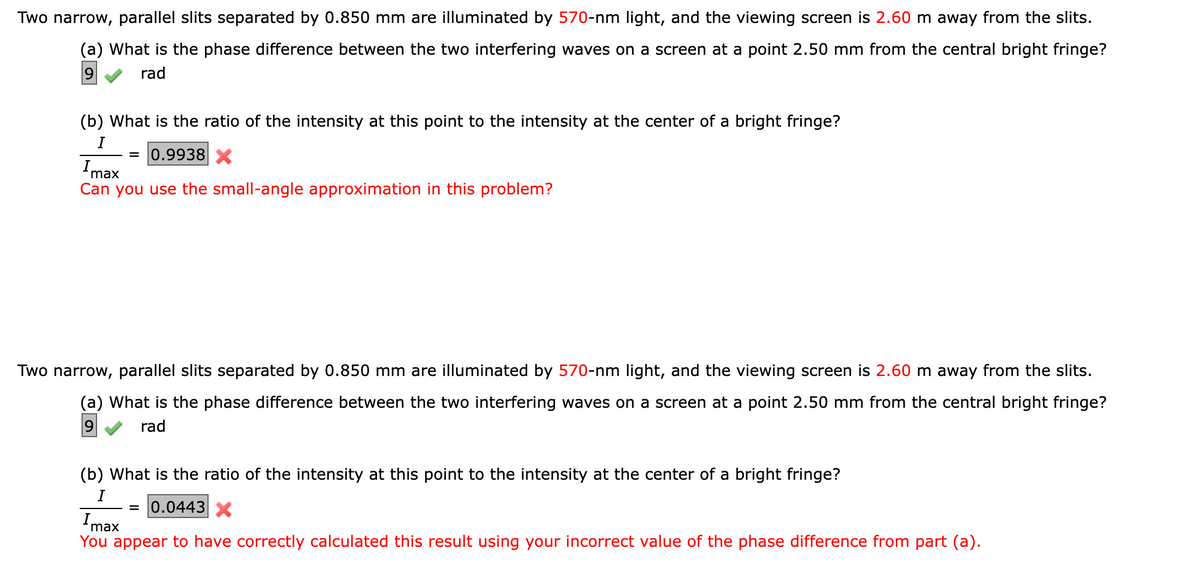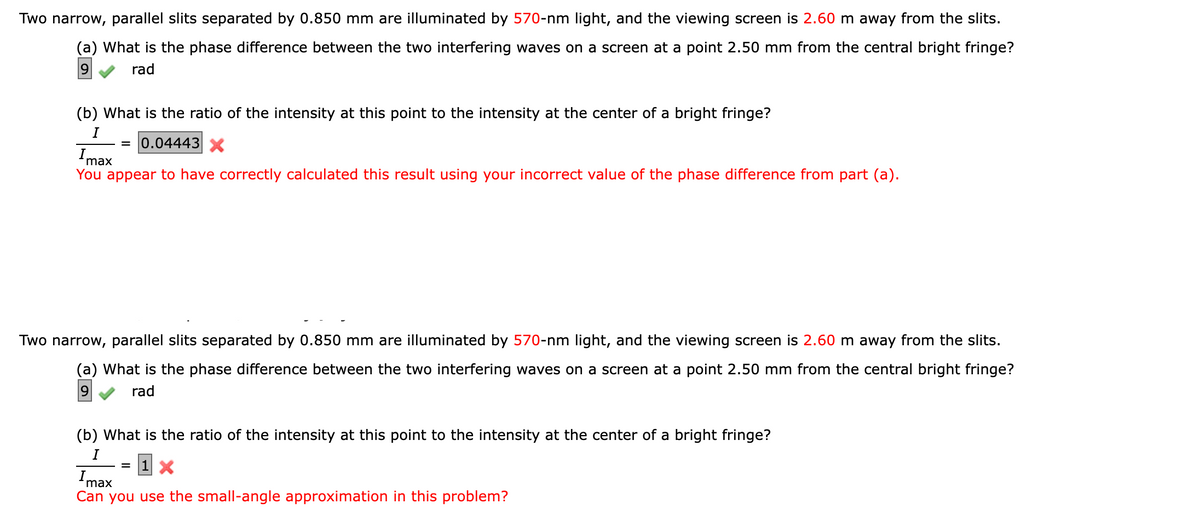Two narrow, parallel slits separated by 0.850 mm are illuminated by 570-nm light, and the viewing screen is 2.60 m away from the slits. (a) What is the phase difference between the two interfering waves on a screen at a point 2.50 mm from the central bright fringe? rad (b) What is the ratio of the intensity at this point to the intensity at the center of a bright fringe? I 0.9938 X Imax Can you use the small-angle approximation in this problem? Two narrow, parallel slits separated by 0.850 mm are illuminated by 570-nm light, and the viewing screen is 2.60 m away from the slits. (a) What is the phase difference between the two interfering waves on a screen at a point 2.50 mm from the central bright fringe? rad Imax You appear to have correctly calculated this result using your incorrect value of the phase difference from part (a). (b) What is the ratio of the intensity at this point to the intensity at the center of a bright fringe? I = 0.0443 X
Two narrow, parallel slits separated by 0.850 mm are illuminated by 570-nm light, and the viewing screen is 2.60 m away from the slits. (a) What is the phase difference between the two interfering waves on a screen at a point 2.50 mm from the central bright fringe? rad (b) What is the ratio of the intensity at this point to the intensity at the center of a bright fringe? I 0.9938 X Imax Can you use the small-angle approximation in this problem? Two narrow, parallel slits separated by 0.850 mm are illuminated by 570-nm light, and the viewing screen is 2.60 m away from the slits. (a) What is the phase difference between the two interfering waves on a screen at a point 2.50 mm from the central bright fringe? rad Imax You appear to have correctly calculated this result using your incorrect value of the phase difference from part (a). (b) What is the ratio of the intensity at this point to the intensity at the center of a bright fringe? I = 0.0443 X
Principles of Physics: A Calculus-Based Text
5th Edition
ISBN:9781133104261
Author:Raymond A. Serway, John W. Jewett
Publisher:Raymond A. Serway, John W. Jewett
Chapter27: Wave Optics
Section: Chapter Questions
Problem 4OQ
Related questions
Question

Transcribed Image Text:Two narrow, parallel slits separated by 0.850 mm are illuminated by 570-nm light, and the viewing screen is 2.60 m away from the slits.
(a) What is the phase difference between the two interfering waves on a screen at a point 2.50 mm from the central bright fringe?
9
rad
(b) What is the ratio of the intensity at this point to the intensity at the center of a bright fringe?
I
= 0.9938 X
Imax
Can you use the small-angle approximation in this problem?
Two narrow, parallel slits separated by 0.850 mm are illuminated by 570-nm light, and the viewing screen is 2.60 m away from the slits.
(a) What is the phase difference between the two interfering waves on a screen at a point 2.50 mm from the central bright fringe?
9 rad
(b) What is the ratio of the intensity at this point to the intensity at the center of a bright fringe?
I
= 0.0443 X
Imax
You appear to have correctly calculated this result using your incorrect value of the phase difference from part (a).

Transcribed Image Text:Two narrow, parallel slits separated by 0.850 mm are illuminated by 570-nm light, and the viewing screen is 2.60 m away from the slits.
(a) What is the phase difference between the two interfering waves on a screen at a point 2.50 mm from the central bright fringe?
9 rad
Imax
You appear to have correctly calculated this result using your incorrect value of the phase difference from part (a).
(b) What is the ratio of the intensity at this point to the intensity at the center of a bright fringe?
I
= 0.04443 X
Two narrow, parallel slits separated by 0.850 mm are illuminated by 570-nm light, and the viewing screen is 2.60 m away from the slits.
(a) What is the phase difference between the two interfering waves on a screen at a point 2.50 mm from the central bright fringe?
9
rad
(b) What is the ratio of the intensity at this point to the intensity at the center of a bright fringe?
I
=
1 X
Imax
Can you use the small-angle approximation in this problem?
Expert Solution
This question has been solved!
Explore an expertly crafted, step-by-step solution for a thorough understanding of key concepts.
Step by step
Solved in 3 steps with 3 images

Knowledge Booster
Learn more about
Need a deep-dive on the concept behind this application? Look no further. Learn more about this topic, physics and related others by exploring similar questions and additional content below.Recommended textbooks for you

Principles of Physics: A Calculus-Based Text
Physics
ISBN:
9781133104261
Author:
Raymond A. Serway, John W. Jewett
Publisher:
Cengage Learning

University Physics Volume 3
Physics
ISBN:
9781938168185
Author:
William Moebs, Jeff Sanny
Publisher:
OpenStax

Physics for Scientists and Engineers: Foundations…
Physics
ISBN:
9781133939146
Author:
Katz, Debora M.
Publisher:
Cengage Learning

Principles of Physics: A Calculus-Based Text
Physics
ISBN:
9781133104261
Author:
Raymond A. Serway, John W. Jewett
Publisher:
Cengage Learning

University Physics Volume 3
Physics
ISBN:
9781938168185
Author:
William Moebs, Jeff Sanny
Publisher:
OpenStax

Physics for Scientists and Engineers: Foundations…
Physics
ISBN:
9781133939146
Author:
Katz, Debora M.
Publisher:
Cengage Learning

Glencoe Physics: Principles and Problems, Student…
Physics
ISBN:
9780078807213
Author:
Paul W. Zitzewitz
Publisher:
Glencoe/McGraw-Hill

Physics for Scientists and Engineers, Technology …
Physics
ISBN:
9781305116399
Author:
Raymond A. Serway, John W. Jewett
Publisher:
Cengage Learning